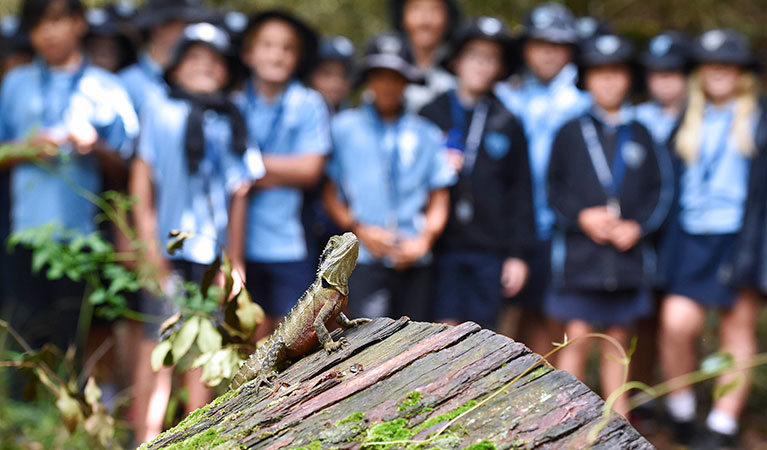School excursion
Exploring the rainforest
Copeland Tops State Conservation Area
Open, check current alerts
Overview
Join us and explore a unique rainforest environment on this Stage 2 (Years 3-4) Geography excursion at Copeland Tops State Conservation Area. Students will conduct field exercises and learn what makes rainforest areas so special.
Read more about Exploring the rainforest
Students will be guided through the dynamic rainforest in the foothills of Barrington Tops. This breathtaking area is the most accessible tract of rare dry rainforest in the Gloucester district. Walking along Copeland Creek, we’ll soak up the scenery under a canopy of red cedar, grey myrtles, shatterwood and many more majestic rainforest species.
The group will discover what a rainforest is and determine why they’re such special places and how we can conserve them. As they explore, they'll identify sustainable practices while considering the significance of the rainforest. Activities along the way may include rainforest art, data collection, a bug survey, nature observation and sensory awareness.
Uncover the mysterious wildlife that call this special place home, including koalas, spotted-tailed quolls, microbats, brush-tailed possums and wompoo pigeons. Students will discover what they eat, where they sleep and how they live in this incredibly diverse environment.
For program outline, safety and practical information about this excursion, see info for teachers
| Stage | Stage 2 (Years 3-4) |
|---|---|
| Learning area | Geography |
| Student outcomes |
GE2-1. Examines features and characteristics of places and environments GE2-2. Describes the ways people, places and environments interact GE2-3. Examines differing perceptions about the management of places and environments GE2-4. Acquires and communicates geographical information using geographical tools for inquiry |
| Objectives |
Students will:
|
Excursion details
- When
Weekdays during school term.
- Availability
- Guided. Available on request.
- Duration
- 2hrs
- Grading
- Easy
- Price
-
$240 for 30 participants (includes GST). Larger school groups welcome, conditions apply.
- Accessibility
- No wheelchair access
- Meeting point
- Copeland Tops State Conservation Area carpark
- Equipment
provided - Yes
- Booking
- If you would like to organise a NPWS school excursion please get in touch with local staff or use the 'Enquire' link for the online form.
Local alerts
For the latest updates on fires, closures and other alerts in this area, see https://www.nationalparks.nsw.gov.au/education/stage-2-geography-exploring-rainforest-copeland-tops/local-alerts
Operated by
- School excursion inquiries - Newcastle Hunter
- 02 4927 3267
- discovery.newcastlehunter@environment.nsw.gov.au
- Hunter Wetland Centre, Sandgate Road, Shortland NSW
Park info
- in Copeland Tops State Conservation Area in the North Coast region
Copeland Tops State Conservation Area is always open but may have to close at times due to poor weather or fire danger.
Info for teachers
All the practical information you need to know about Exploring the rainforest.
Program outline
- Welcome, acknowledgement of Country and safety talk.
- Introduction to the site and overview of the day
- Walk to Mountain Maid gold mine, morning tea, toilet break.
- Discover what a rainforest is, determine why they’re such special places and how we can conserve them.
- Investigate features of this ancient rainforest, including stranger figs.
- Participate in activities including nature observations, data collection, a bug survey and sensory awareness
- Lunch
- Return to bus along Copeland Creek
- Return to carpark via toilets. Farewell and depart on bus.
Getting there and parking
Get driving directions
To get to Copeland Tops State Conservation Area from Gloucester:
- Follow Thunderbolts Way northwest out through the village of Barrington and over the single-lane bridge
- Continue west on Barrington Tops Forest Road until you come to Copeland village
- Turn left onto Copeland Road and follow this road to the carpark at the end
What to bring
Please wear long pants, closed comfortable shoes and bring a hat and sunscreen. Be ready for all weather conditions with a jumper and raincoat. And remember to bring food and any necessary medications.
It’s a good idea to pack your belongings in a backpack rather than a plastic bag because we have some curious birds who may try to break in and share your lunch with you.
Maps and downloads
Risk assessment and risk benefits
Our rangers and guides have the technical skill and experience to assess the risks and the benefits of a variety of activities delivered as part of our learning programs.
We believe in including opportunities that allow students to learn and experience for themselves through exploration in the natural environment.
Please make your own risk assessment based on the information provided. Detailed potential risks and controls are provided for the site to assist teachers in risk management planning. Teachers and carers should be aware of, and consider the needs, abilities and medical conditions of students when visiting this site. The supervision of students remains the responsibility of the teacher. The school must ensure an adequate number of adult supervisors are present.

